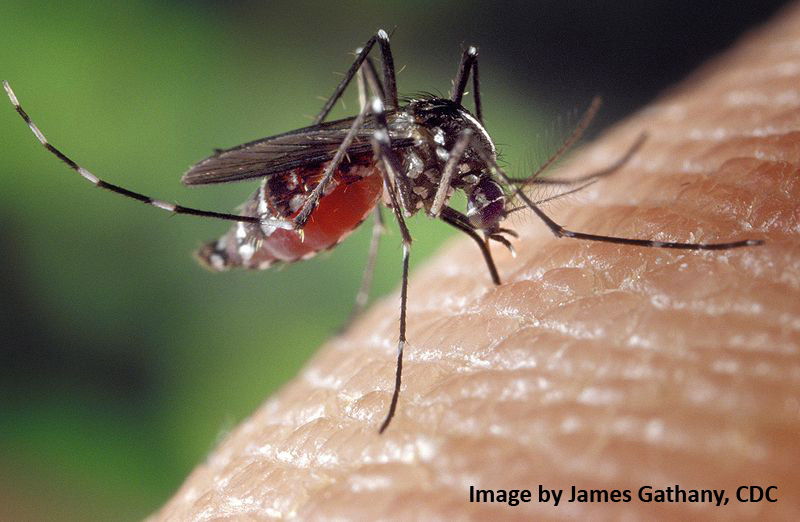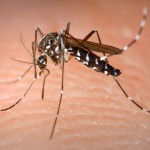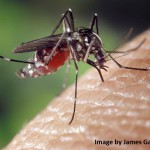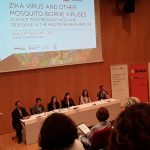Viral comments (21): Dengue virus, another pathogen, now globalized, which knocks at our door

There are a number of vector-borne diseases, those that are by arthropod vectors such as mosquitoes and ticks, which are becoming more likely in our regions as a result of globalization (especially in what it has to facilitate the movement of goods and people), and disturbances caused by climate change. One of these diseases with a high probability to finally settle in Catalonia is dengue.
Some quick pills of dengue:
- Dengue virus is transmitted mainly by female mosquitoes of the species Aedes aegypti and, to a lesser extent, Aedes albopictus (our tiger mosquito). So Dengue basically rules between latitudes 35°N and 35ºS and below 1000 meters, the habitat for these mosquitoes.
- The Aedes aegypti mosquito lives in urban habitats and breeds primarily in human-made containers. Unlike other mosquitoes, it feeds during the day; the periods of active biting are the morning and the evening, before dark. At each feeding period, a female mosquito can sting many people.
- Aedes albopictus, a secondary dengue vector in Asia, has spread to Canada, United States and Europe because of the international trade in used tires (which provide shelter to mosquitoes) and the circulation of goods (for example, the lucky bamboo); These mosquitoes have a great ability to adapt to new environments; their tolerance of subzero temperatures, their ability to hibernate and its ability to shelter in microhabitats are factors that have led to its spread in Europe (and in Catalonia, specifically).
- Dengue is a “human” virus. We are the reservoir, the primary host, although the virus came from non-human primates. It is the female mosquito that feeds on an infected human, and after an incubation period of the virus that lasts 4 to 10 days, becomes competent vector, efficient transmitter of the pathogen throughout life and, moreover, she can transmit it to its offspring. However, a mosquito sucking infected blood can not immediately transmit the virus, the disease. The virus must pass from the mosquito gut to other tissues until it reaches the salivary glands, to finally be excreted through saliva, which is injected with each bite. This process, as mentioned earlier, takes from 4 to 10 days.
- A single infected person can transmit the virus to female Aedes mosquito after the onset of symptoms for a period of 4 or 5 days, 12 days at most.
- The dengue virus is a flavivirus of the Flaviviridae family. Classically four different closely related serotypes are known: DENV-1, DENV-2, DENV-3 and DENV-4. A few years ago (2013) it was described a fifth type, the DENV-5, which has been around for hundreds/thousands of years in a forest circulation (in the jungles of Malaysia and Indonesia), and has rarely affected humans. When a person recovers from the infection acquires lifelong immunity against the particular serotype and a partial, temporary, short-term cross immunity with respect to the other serotypes. A person infected with one serotype and, some years later, is infected again with a different serotype, has a higher risk of suffering severe dengue.
- Dengue is a viral infection that initially presents flu-like symptoms and sometimes evolves into a life-threatening condition called severe dengue.
- In recent decades the incidence of dengue has greatly increased in the world. Before 1970 only nine countries had experienced epidemics of severe dengue, now is endemic in more than 100 countries of Africa, the Americas, the Mediterranean East, Southeast Asia and the Western Pacific. In 2013 cases have been recorded in Florida (USA) and the Yunnan Province (China), and dengue has also been reported in Japan after a silence of more than 70 years. About half of the world population, 2,500 million people living in 128 countries, is at risk of contracting this disease. In Asia and Latin America it has become one of the leading causes of hospitalization and death of infants. It is estimated that between 200 and 500 million people are infected annually by the virus of dengue, especially in the tropical and subtropical belt, and inside this, especially in urban and semi-urban areas. Of all the infected people, around one million needed hospital care and 25,000 died.
- The virus has already left its mark in Europe; it was first reported in France and Croatia in 2010, and imported cases were detected in three other European countries. In 2012, an outbreak of dengue in Madeira (Portugal) caused more than 2,000 cases. Imported cases were reported in 10 other European countries in addition to continental Portugal.
- There is no specific treatment for dengue and severe dengue (DHF was called before), but early detection and access to adequate medical care decrease mortality rates of over 20% to less than 1%. It is crucial to maintain the volume of body fluids.
- As there is no specific post-exposure treatment, dengue control lies in preventive measures that rely solely on effective vector control measures. Several of these measures are:
- To prevent mosquitoes find places to lay their eggs, basically stagnant water and wet locations
- To cover, empty and clean containers each week where domestic water is stored
- To apply appropriate insecticides to containers in which water is stored in the open
- To use personal protection at home, as screens on the windows, long-sleeved clothing, insecticide-treated materials, spirals and sprays
- During outbreaks, vector control measures may include emergency application by spraying insecticides
- Active surveillance of vectors to determine the effectiveness of control measures
But what makes an arthropod vector competent? What makes an arthropod able to transmit the dengue virus? Any mosquito is capable, has this ability? A really good question, this one.
But this, this is another story.













